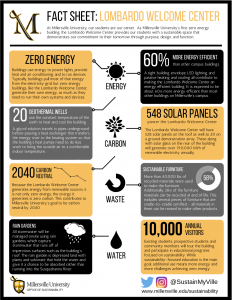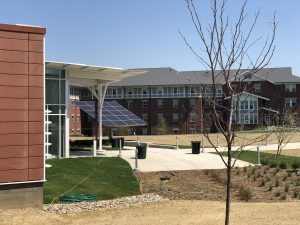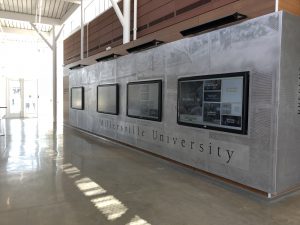Millersville University becomes one step closer to being Carbon Neutral by 2040.
May 2016 – Starting construction on the Lombardo Welcome Center
February 2018 – Opening of the Lombardo Welcome Center
All over the United States, we travel through cities and towns that require energy to provide us with power, air conditioning, heat and electricity to power our many different appliances and electronics.
Renewable sources of energy have been researched for years now and include the study of solar panels, nuclear energy, or even wind power among many others.
Imagine if huge businesses, corporations, and educational institutions were able to power an entire building through renewable sources which not only would serve as being green an environmentally friendly, but had the power to sustain itself?
With the help of a $1.2 million dollar donation from the generous Samuel and Dena Lombardo, Millersville University has taken a big step forward with its green initiatives towards sustainability with the installation of the latest zero energy building, the Lombardo Welcome Center.
What is the Net-Zero Energy Building?
A building which generates as much energy as the building needs to run from renewable sources over the course of a year. The location of the building is right in the heart of campus near the student’s residential halls and open quad and next to the dining facilities such as the Anchor and the Upper Deck. The building itself is used as:
- A central hub for students and the community alike to learn more about Millersville University as well as other information about sustainability
- A presentation room for campus tours to show incoming students about the university
- Home for the Marketing & Communications, Admissions, Housing and Sustainability Offices
What makes the Lombardo Welcome Center different than other buildings on the Millersville University campus is it offers the ability to produce energy to power itself. Unlike other buildings that generate excessive energy through powering their lights, computers and climate control the Lombardo Welcome Center has been built from the grown up with green initiatives in mind.
Right outside the building a large solar panel can be found that rotates during the day to face the sun and collect solar power. The building roof itself also has been equipped with approximately 300 solar panels to collect and store energy to then distribute during the day. This allows for the building to provide energy for:
- The University departments housed in the whole building
- The climate control system
- Office computers
- Lights
- Other electronic appliances and equipment

Zero Net Energy Facts Sheet: Lombardo Welcome Center. Chart provided by Chris Steur; Sustainability Manager at Millersville University.
How Do They Monitor Energy Use?
How much energy does the building actually consume though and how do they monitor it? Well, energy on Millersville’s campus is monitored every 15 minutes as well as on a monthly scale. You can also view it on the university website to see it’s day to day energy use. The building generates about 175,000 kilowatts a year which is enough to power itself.
Green Technology – Heat Pumps
The Lombardo Welcome Center is not only conserving energy in the means of providing solar energy. A lot of thought has also been put into the heating and cooling systems of the building in an effort to sustain its energy use.
Geothermal technology is implemented for the heating pumps connected to the building. Geothermal heat pumps use the advantages of the earth’s temperature being cooler than the outside air during the summer, and warmer than the outside air during the winter to help provide heating and cooling solutions as to not overuse the heat pumps. With about 20 wells stationed underground near the rear of the building, less use of the heat pumps results in less energy consumption.
The Lombardo Welcome Center was achieved through President John Anderson’s commitment to sustainability as well as a generous donation by Samuel N. And Dena M. Lombardo. With its
completion, it is a physical representation of Millersville University’s commitment to being carbon neutral by 2040.
Chris Steuer
Sustainability Manager at Millersville University
As Millersville University’s Sustainability Manager, Chris oversees the sustainability projects such as the latest, Zero Net Energy Building, the Lombardo Welcome Center. Other programs he oversees include Millersville Climate Action Plan as well as incorporating green initiatives into the University’s overall activities. Prior to his work at Millersville University, he helped develop sustainability assignments for the U.S House of Representatives, National Park Service, and the Environmental Protection Agency to name a few.
Samuel N. and Dena Lombardo
CEO of the Benecon Group

Samuel N. and Dena Lombardo. Photo taken by Suzette Wenger: Staff Photographer from Lancaster Online.
Samuel Lombardo serves as the chairman of a Lititz based insurance agency, the Benecon group. As a Lancaster country entrepreneur, he and his wife helped towards the building of the now Lombard Welcome Center. The Lombardo’s donated a total of $1.2 million dollars towards the $7.5 million dollar zero net energy building project. It is among the top private donations in Millersville’s history. Millersville University awarded Lombardo an honorary doctorate back in 2007.
Related Stories:
Growth in Net Zero Building Industry
Staying green and taking steps towards sustainability have really propelled in recent years. Zero Net Energy based projects look for educational buildings, corporate facilities, public buildings, and other institutional sites to implement and maintain a more sustainable environment. Ways to sustain the earth and drain less power is necessary, particularly with the heating, ventilation, and air conditioning (HVAC) systems being one of the most crucial and most energy-consuming systems involved in the construction of a building. The United States is leading other countries in having more verified zero energy buildings.
Solar Panels: Solar Energy
There are many different sustainable methods of collecting energy. Whether wind power, geometric heating, or even solar energy. Solar power is one of the most popular as every day the sun’s energy is readily available and solar power cells are able to store this energy for future use. With more and more electronic devices available, charging them using electricity has always been a market of research. One of the ways engineers has combatted this industry, is with producing solar panel charged battery packs in order to store energy to charge our devices.
Sources:
(n.d.). Retrieved from https://buildingos.com/s/millersville/storyboard573/?chapterId=2796
The Lombardo Welcome Center: What We Know. (n.d.). Retrieved from http://blogs.millersville.edu/news/2018/02/05/the-lombardo-welcome-center-what-we-know/
Lombardo Welcome Center. (n.d.). Retrieved from http://www.millersville.edu/sustainability/sustainable-campus/buildings-and-energy/NZEB.php
Office of Sustainability. (n.d.). Retrieved from http://www.millersville.edu/sustainability/organization-and-activities/office-of-sustainability.php
Wenger, S. (2015, August 28). Samuel and Dena Lombardo. Retrieved from https://lancasteronline.com/news/samuel-and-dena-lombardo/image_82ba7930-4dc6-11e5-bdb1-3ff43eb0ad9d.html





